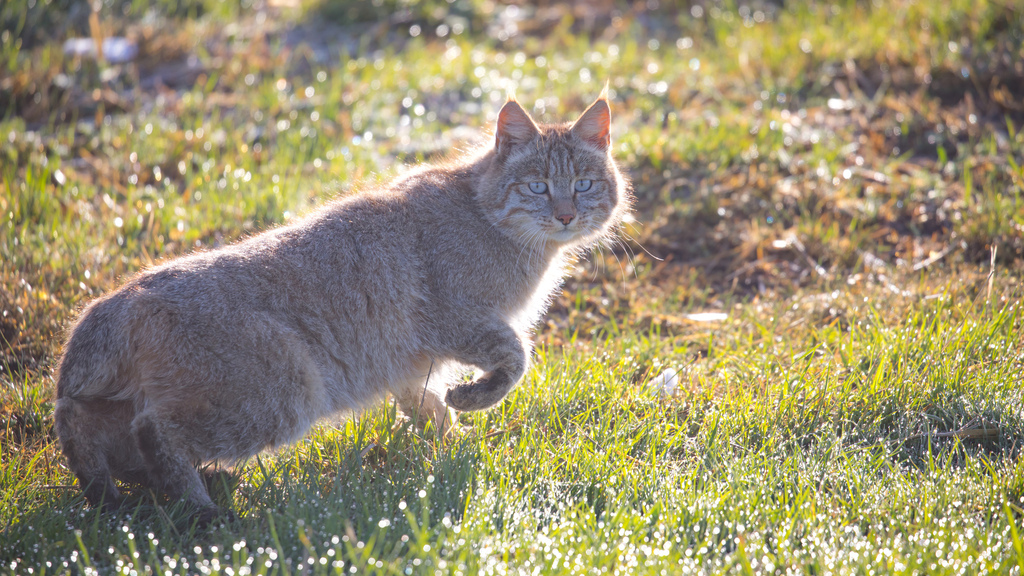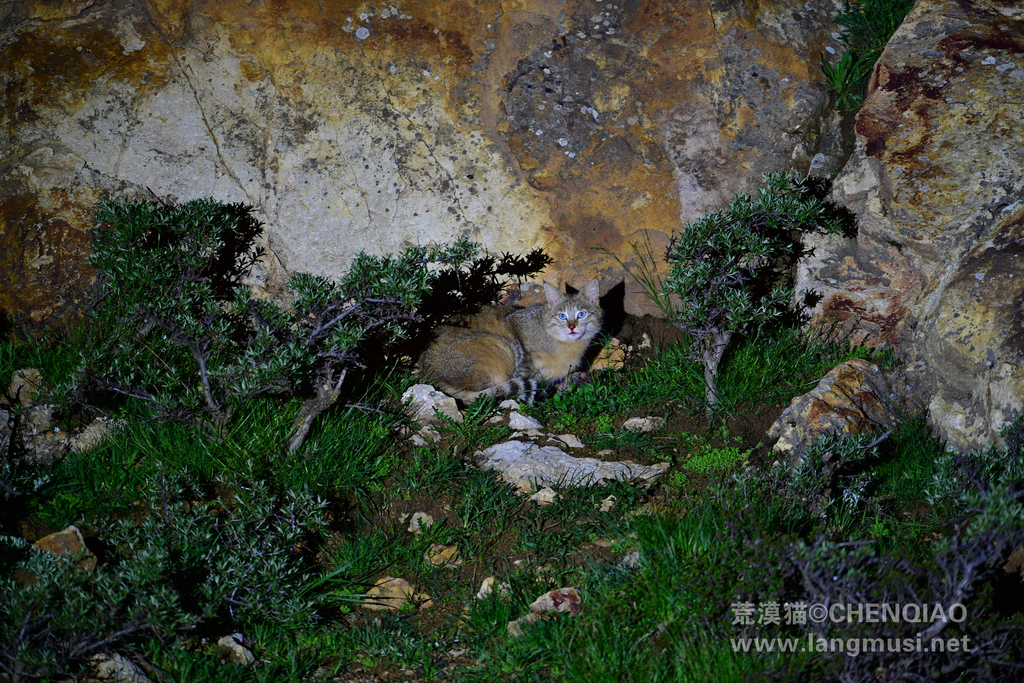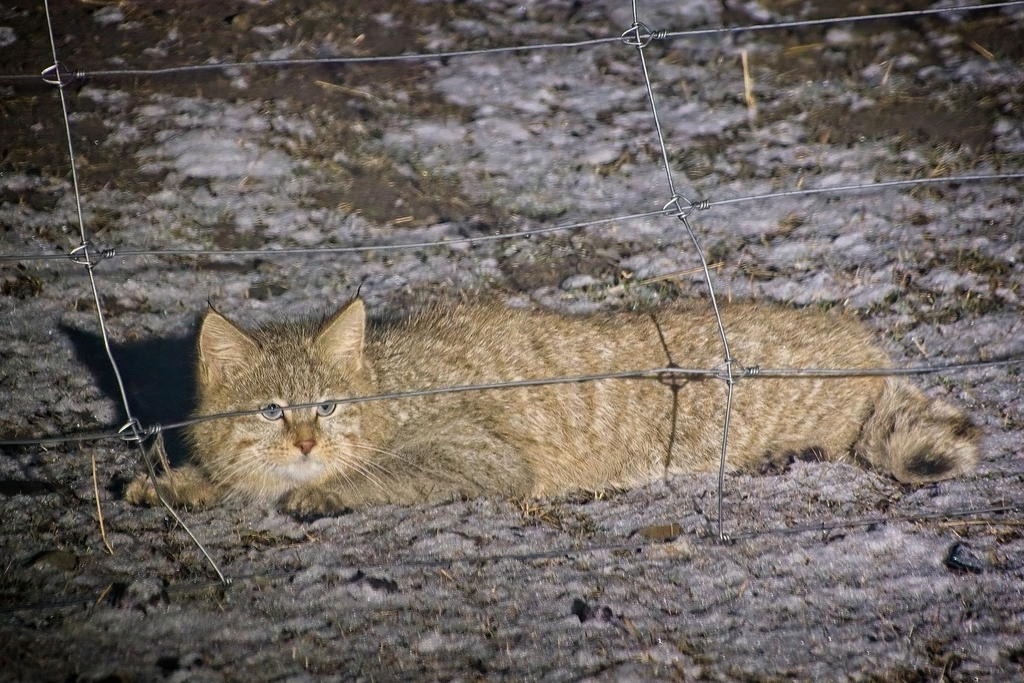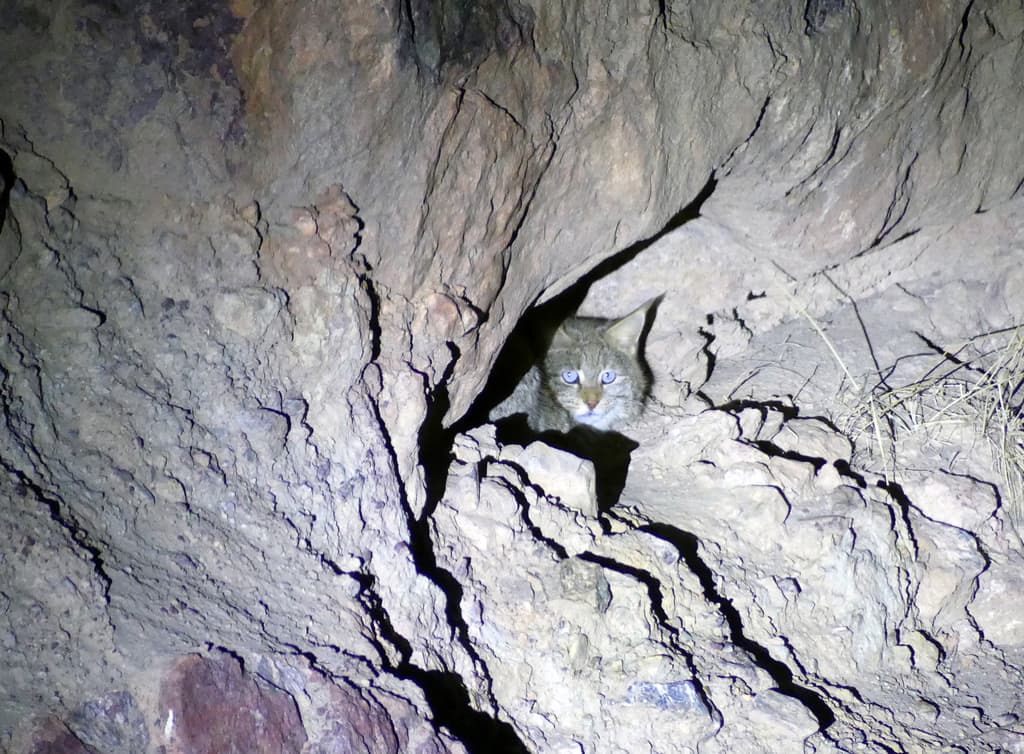Chinese Mountain Cat Profile
The mystery of the inspiration for Lewis Carroll’s Cheshire Cat character has spawned several hypotheses, but one that’s not yet popular is that the child’s author sneaked off to China during his stint in Russia, took some special mushrooms and bumped into an endemic feline: the Chinese Mountain Cat.
This is probably because it’s almost certainly untrue but in the spirit of “Just asking questions” we put forward this baseless and unfalsifiable suggestion here.
The cat in question is a stocky, tufted little predator from the highlands of China, and may or may not be of the opinion that “Imagination is the only weapon in the war with reality.”

Chinese Mountain Cat Facts Overview
| Habitat: | Chinese mountains: high-elevation grassland |
| Location: | China, Mongolia, Tibet |
| Lifespan: | Unknown, possibly around 14 years |
| Size: | Up to 84 cm (33 in) long, with another 41 cm (16 in) of tail |
| Weight: | Up to 9 kg (20 lb) |
| Colour: | Sandy grey with a banded tail |
| Diet: | Pikas, rodents, birds. |
| Predators: | Wolves, brown bears, and other large predators. |
| Top Speed: | Unknown |
| No. of Species: | 1 |
| Conservation Status: | Vulnerable |
The Chinese Mountain cat does exactly what it says on the tin. This animal is slightly larger than a domestic cat but a lot more cheeky-looking and a formidable foe for everything beneath it on the food web in the Chinese highlands.
As a significant controller of populations for its prey species – mainly rodents and pikas – its role in the ecosystem is unquestionable, but unfortunately humans have done what humans always do in their infinite wisdom and tinkered about with things to make them worse.
The population isn’t quite on the brink, but it’s getting there, and being such a difficult animal to study, conservation efforts are slow to arrive.
Interesting Chinese Mountain Cat Facts
1. They’re closely related to jungle cats
Sometimes called the Chinese desert cat, this is a Felis species that lives wayyyy up in the Chinese mountains, in areas of scrub and open grassland, though it has not been confirmed to live in true desert.
They’re not huge, but they’re still the top predator in these barren landscapes, feeding mostly on rodents and pikas and some birds, which they hunt by ambushing from a camouflaged position in the scrub.
The Chinese Mountain cat is then essentially a high-altitude plains variant of the Jungle cat, Felis chaus, which is a frownier, but farther-reaching and forest-friendly feline from the foothills of the Caucasus and the Eastern Mediterranean region.
And this is handy because it is the jungle cat that forms the basis for a lot of assumptions about its cousin, simply because it’s a hell of a lot easier to find.

2. They’re elusive
By now, it’s more or less a given that if we’re talking about a wild cat species, we’re going to include this fact. While the jungle cat can also be hard to find, its Chinese Mountain cousin is a very secretive animal, in no small part because of its preference for elevations of up to 5,000 metres.
It’s also a nocturnal hunter, adding yet another dimension of mystery to its mystique. For these reasons and more, it was first photographed in 2007, the same year the first iPhone was introduced by Steve Jobs. Coincidence? Almost certainly, yes.
The first breeding den was only discovered in 2018, the same year the Chinese cloned their first monkey, which likely had nothing to do with it either.
To make matters worse, like most cats, this one is solitary, so there aren’t many of them about, and they tend to only come together when nature calls and they need to find a mate to get their rocks off with. 1
3. They’re Chinese
The clue is in the name, but there are no other cats quite as Chinese as this one (Some accounts consider them endemic to China, but this might be a bit of a controversial statement since they’re also said to have been spotted in inner Mongolia, which even China recognises as independent).
This is predominantly a Chinese cat and with a range limited mostly to the Chinese Mountains and highlands found in the North of the country, and critics suggest the Mongolian sightings are cases of mistaken identity, which would indeed make them the only endemic species of cat to China. 2

4. Not much else is known about them
The precise taxonomy of this cat is still not fully established, and its population trends are not known. Much is left up to the imagination when it comes to sex and social interaction, too.
Specimens are caught in traps and found in tourist markets in China, and local people make hats from their fur, as well as seat furs and wristbands. But it’s farmers who provide the biggest threats.
5. They’re killed by rat poison
Unfortunately for almost every mammal that eats it, rat poison is a misleading name for a toxin that is pretty much indiscriminate.
Rat poisons come in many forms, none of them very nice, and when used to control rodent and pika populations by farmers in the region, they also work pretty well on the predators of these animals.
Skin and fur trades are, to a lesser degree, a threat – the pelts do show up in Chinese wet markets – but likely the invasion of domestic cats that come with the expansion of humans is going to be a stronger pressure on the species.
Ironically, most of what is killing this cat comes from an attempt to fix a problem it already solves. 3
6. They’re good to have around
The reason rat poison is such an issue for the mountain cat is that it hunts the very animals the farmers are trying to rid themselves of.
Some farmers believe that the cat also eats the grasses that their livestock consume and persecute them as pests, but more enlightened individuals actively encourage their presence as pest controllers.
7. They’re in decline
The general population looks to be doing poorly, and it’s estimated that fewer than 10,000 individuals are left, probably in decline.
They’re now protected under Category 1 of the Chinese Wildlife Law and Appendix 2 of CITES, and while wider poisoning campaigns were halted when it was noticed that the cats were being harmed, the practice continues locally among small-scale farmers. 4

Chinese Mountain Cat Fact-File Summary
Scientific Classification
| Kingdom: | Animalia |
| Phylum: | Chordata |
| Class: | Mammalia |
| Order: | Carnivora |
| Family: | Felidae |
| Genus: | Felis |
| Species: | bieti |
Fact Sources & References
- Xue-Song Han (2020), “Discovery of first active breeding den of Chinese mountain cat (Felis bieti)”, PubMed Central.
- “Chinese Mountain Cat”, International Society for Endangered Cats (ISEC) Canada.
- “Chinese Mountain Cat”, IUCN Red List.
- Laura Maihofer, “Felis bieti Chinese desert cat”, Animal Diversity Web.
